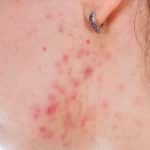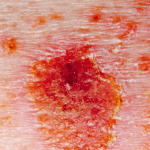What Is Folliculitis?
Eczema is a common skin condition that causes the skin to become inflamed. Also known as dermatitis, eczema comes in many different forms, but most forms leave you with such symptoms as redness, itching, scaling, cracking, and sometimes fluid-filled blisters. Whenever you see any rash, redness or scaling on your skin, or on your child’s skin, it’s always best to see your dermatologist, who can expertly diagnose which skin condition you actually have, and start treatment to begin the healing process, returning your skin to its smooth, flaw-free condition.
Even though we’re entering ‘cover-up’ season of fall and winter, when you might be tempted to just cover up what you might chalk up to ‘extreme dry skin’ or a skin allergy with yoga pants, sweats, jeans and sweaters, covering up your eczema problem is only going to lead to bigger flare-up or constant problems down the road. And why live with that itchiness and partner-repelling scaliness?
Here are some of the most common forms of eczema that your board-certified dermatologist can diagnose:
Atopic Dermatitis: The most common form of eczema, this type may arise if you have a family history of eczema, asthma or hay fever, and can begin during infancy or childhood but can arise in people of any age. This type of eczema will be seen most often on the face, hands, back of the knees, inner elbows and feet. Scratching can make this type of eczema worse, turning affected skin areas thick and red, and can create wounds that can become infected.
Contact Dermatitis: You may have heard about this form of eczema when researching all-natural laundry products and organic skin cleansers, touted as a skin condition irritated by product chemicals. But contact dermatitis occurs in two forms — irritant contact dermatitis and allergic contact dermatitis. These forms of eczema can develop after a substance damages the skin – like those harsh laundry chemicals in non-organic products, and it can also occur after frequent hand-washing, which happens very often as you attempt to get through flu season without getting sick. You might develop irritant contact dermatitis after touching a strong irritant one time (that’s all it takes sometimes) or by frequent exposure to the same irritant (like not connecting your skin issues to your brand of laundry detergent or fabric softener and putting on clothes that irritate your skin.) Some people experience this form of eczema after touching nickel or putting on cosmetics that don’t react well with their skin. One of the most common spots for contact dermatitis is the hands.
Dyshidrotic Dermatitis: This form of eczema most often occurs on the hands and feet, starting off most commonly as severe itching, then turning into blisters, then scaly patches. This type of eczema can be painful and may become chronic. The cause is unknown.
Continue reading below…
Nummular Dermatitis: With this type of eczema, coin-shaped red marks can occur on the skin, most commonly on the legs, backs of the hands, lower back, hips and forearms. The cause is unknown, but this type tends to get extra-aggravated in cold, dry air or when in contact with nickel.
Neurodermatitis: This type of eczema may develop in spots that you frequently scratch out of habit, such as the sides or back of the neck, ankles, inside the ear, wrists, scalp, and other spots. Some people scratch these areas while asleep, waking up with red, telltale eczema patches that can grow thick and wrinkled, and infected.
People with this type of eczema develop skin irritation in spots that they frequently scratch out of habit.
Seborrheic Dermatitis: You know this type of eczema as dandruff, and what may surprise you is that it’s not just your scalp that can develop those embarrassing flakes. Other spots known to develop dandruff are the eyebrows, the center of the chest, the sides of the nose, the area behind the ears, and the groin. Seborrheic dermatitis causes skin to fall off in small to larger flakes and may be due to an overgrowth of a type of yeast, combined with the rapid shedding of cells on the scalp
Continue reading below…
Stasis Dermatitis: Quite different from dandruff symptoms, this type of eczema can develop in people when the veins in their lower legs don’t properly return blood to their heart. What forms is crusting of the skin and oozing, and brown stains can form on the skin.
Talk to your dermatologist about any red, itchy, scaly or changed areas of your skin, to get right on the healing path with natural and prescribed eczema treatments.
Source:
https://www.webmd.com/skin-problems-and-treatments/eczema/types-of-eczema?page=3





